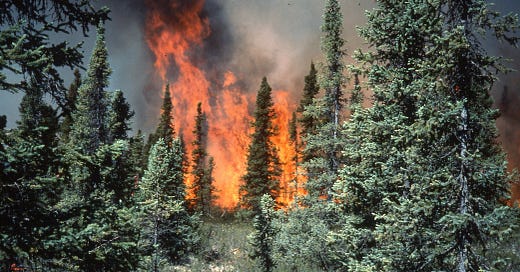So wildfires. What’s the climate connection?
Rising temperatures have increased evaporation rates. On land, this means the air is less humid overall and soils dry out faster. Combine this drying with a warm spell in an area with forests and you’ve created a tinder box waiting to explode.
I wrote about this a few issues back. Here’s the relevant Need-to-Know: Higher evaporation rates bring more wildfires, droughts, including flash droughts.
(See NtK A Fundamental Change to the Earth’s Water Cycle is Underway.)
Now, how does the forest-tinder box turn into a wildfire? Three main ways:
Lightning is the biggest way, and almost always with fires in remote areas
Human stupidity. That is a deep well and I’m not going there.
Other wildfires. Embers from existing fires can travel many miles (kilometers) and start another fire.
Need-to-Know: Yes, climate change does cause wildfires.
Climate change is creating ideal conditions for fires to start.
Climate also provides the spark in the form of increasing lightning activity.
Need-to-Know: Climate change causes more lightning
Yes, climate has increased the amount of lightning. A one-degree C increase in temperature amounts to about 12% more lightning. (That’s a lot, as in 500,000 to 600,000 more lightning flashes in Canada alone.)
We know this because of lightning detection networks that use special sensors and satellites to track cloud-to-cloud and cloud-to-ground lightning. The combined Canada-US network is the world’s largest. Hardly anyone seems to know about them but I first wrote about them way back in 2000.
Need-to-Know: The US sees around 200 million lightning strikes a year
The lightning season in Canada starts in April. Most of the US has lighting year around and is one of the world’s lightning hotspots. And we’re talking about a lot of lightning, as in around 200 million individual lightning events a year. (Texas and Florida see the most.)
Wildfires in Canada this year are likely to be the worst ever. At nearly 3 million hectares burned, this is 13 times worse than the 10-year average at this time of year. Few of the 500 current fires are under control.
Need-to-Know: Wildfires in one forest region emitted 1.8 billion tons of CO2
Wildfires pose enormous risks to people, homes, and to the climate. You may find this hard to believe as I did, but in the summer of 2021 fires in the Boreal forests of Canada, Alaska, and Siberian Russia produced record emissions estimated at 1.8 billion tons of CO2. (See March 2023 study in the journal Science.)
That’s more CO2 than Russia produces in a year.
Let’s hope that won’t happen again this year.
Until next time, be safe.
Stephen
Welcome to Need to Know: Science & Insight, my personal newsletter that looks at what we Need-to-Know at this time of pandemic, climate emergency and unraveling of nature’s life supports





